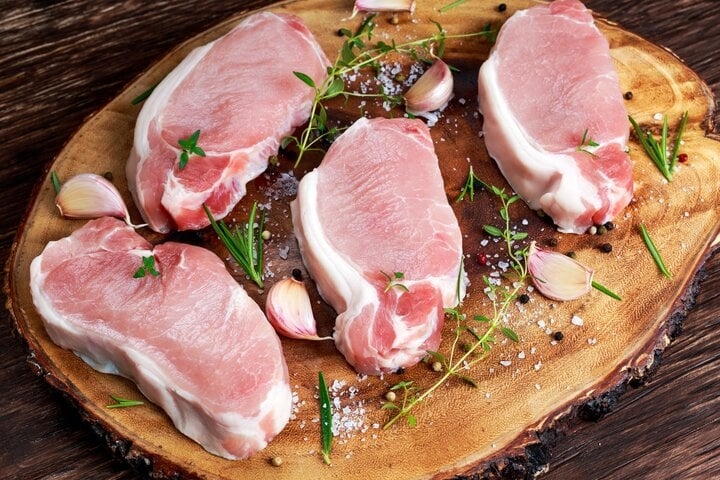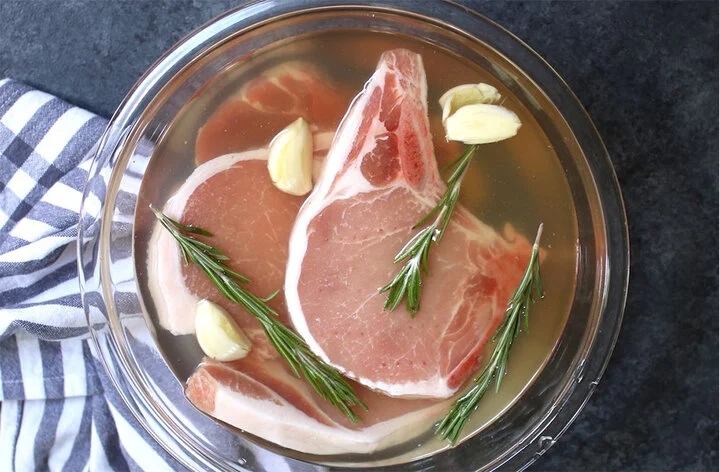Refrigerators are a staple in modern households, helping to preserve food and keep it fresh and safe. However, there are special cases such as prolonged power outages that can render fresh food unsafe. In these situations, it’s essential to know alternative methods to preserve meat, particularly pork, which is a popular choice for many families.
Alternative Ways to Preserve Pork Without a Refrigerator
Knowing how to preserve pork without a refrigerator is a valuable skill that has been somewhat forgotten but remains crucial in emergency situations or when there is no access to refrigeration. The following traditional methods are simple and effective.
Salt Curing
Salt is a natural preservative that inhibits bacterial and mold growth, helping to extend the shelf life of pork. This method involves coating the meat with salt and allowing it to cure.

Salt curing is an effective way to preserve pork without refrigeration. (Image: Butcher.ie)
To cure pork with salt, start by rinsing the meat with clean water and patting it dry with a paper towel. Apply salt generously to all surfaces of the meat, making sure to rub it into the crevices. Place the salted pork in a container or a sealed plastic bag and store it in a cool, dry place. This method can keep pork fresh for up to two weeks.
When you’re ready to cook the salted pork, be sure to rinse it thoroughly with clean water to remove excess salt.
Sun-Drying
Sun-drying is a traditional method of preserving pork that has been practiced for generations. The process involves cutting the meat into thin, long strips, marinating it in a mixture of salt and spices, and then drying it in the sun until it is completely dehydrated.
To prepare the pork for sun-drying, start by rinsing it with clean water. Cut the meat into thin, long strips, and then season it with salt, pepper, garlic, and chili peppers to taste. Hang the meat on a line or rack and expose it to direct sunlight until it is completely dry. The drying process can take several days to a week, depending on the weather conditions.
Smoking
Smoking is a time-honored technique that not only preserves meat but also imparts a unique flavor. To smoke pork, start by cleaning the meat and cutting it into large chunks. Season the meat with salt and any desired spices, and then place it in a smoker. Burn wood, typically from fruit trees or oak, to generate smoke, and smoke the meat at a low temperature for several hours until it is dry and has absorbed the smoky flavor.
Vinegar Pickling
Vinegar has acidic properties that inhibit bacterial growth and add a unique flavor to the meat. This method involves submerging pork in a mixture of vinegar, salt, and spices, creating a safe and flavorful environment for the meat.

Vinegar pickling is an effective way to preserve pork without refrigeration. (Image: Tipbuzz)
To pickle pork, start by cutting the meat into bite-sized pieces. Prepare a brine by mixing white or apple cider vinegar with a small amount of salt and your choice of spices. Ensure that the meat is completely submerged in the brine and store it in a sealed jar in a cool, dry place. This method can keep pork fresh for up to one week.
In addition to its preservative effects, vinegar also helps tenderize the meat, reducing cooking time.
Preserving in Pork Fat
This method involves cooking the pork slightly and then submerging it in melted pork fat, which acts as a natural preservative. To prepare the pork, clean it and cut it into bite-sized pieces. Either boil or pan-fry the meat briefly to eliminate bacteria. Next, melt pork fat and pour it over the meat in a clean jar, ensuring the meat is completely covered. Allow the fat to cool and solidify, then store the jar in a cool, dry place.
This technique can preserve pork for several weeks to months, but it is most effective in cooler temperatures or during winter.
Sugar Curing
Sugar has moisture-absorbing properties and creates an environment that is unfavorable for bacterial growth, making it an excellent preservative for pork. After purchasing fresh pork, rinse it and cut it into portions. Apply a thin, even layer of sugar to the entire surface of each piece of meat, and you can also add a small amount of salt to enhance preservation. Place the sugar-coated pork in a container or sealed bag and store it in a cool, dry place. This method can keep pork fresh for up to one week.
Preserving in Alcohol
Alcohol is an effective disinfectant and preservative for pork. Clean the meat and cut it into bite-sized pieces. Briefly soak the meat in alcohol to disinfect it, and then remove it and allow it to air dry. Store the meat in an airtight container to keep it fresh for several days.
Preserving with Betel Leaves
Betel leaves have natural antibacterial properties, making them ideal for preserving pork. Clean the meat and cut it into thin slices. Wrap each slice of pork in a betel leaf, and then place the wrapped meat in a sealed container and store it in a cool, dry place. This method can keep pork fresh for up to one week.
According to VTC News
The Ultimate Guide to Meat Preservation: Keep Your Meat Fresh for Up to Six Months
If you’re a pork lover and tend to buy in bulk, it’s important to know the right way to store it to maintain its freshness and quality. Instead of rushing to stash it in the fridge, there’s a simple extra step you can take to ensure your pork stays fresh and tastes just as delicious as the day you bought it.


































